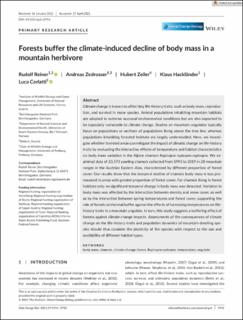| dc.contributor.author | Reiner, Rudolf | |
| dc.contributor.author | Zedrosser, Andreas | |
| dc.contributor.author | Zeiler, Hubert | |
| dc.contributor.author | Hackländer, Klaus | |
| dc.contributor.author | Corlatti, Luca | |
| dc.date.accessioned | 2022-03-21T11:28:55Z | |
| dc.date.available | 2022-03-21T11:28:55Z | |
| dc.date.created | 2022-02-25T11:20:57Z | |
| dc.date.issued | 2021 | |
| dc.identifier.citation | Reiner, R., Zedrosser, A., Zeiler, H., Hackländer, K. & Corlatti, L. (2021). Forests buffer the climate-induced decline of body mass in a mountain herbivore. Global Change Biology, 27(16), 3741-3752. | en_US |
| dc.identifier.issn | 1354-1013 | |
| dc.identifier.uri | https://hdl.handle.net/11250/2986426 | |
| dc.description.abstract | Climate change is known to affect key life-history traits, such as body mass, reproduction, and survival in many species. Animal populations inhabiting mountain habitats are adapted to extreme seasonal environmental conditions but are also expected to be especially vulnerable to climate change. Studies on mountain ungulates typically focus on populations or sections of populations living above the tree line, whereas populations inhabiting forested habitats are largely understudied. Here, we investigate whether forested areas can mitigate the impact of climatic change on life-history traits by evaluating the interactive effects of temperature and habitat characteristics on body mass variation in the Alpine chamois Rupicapra rupicapra rupicapra. We examined data of 20,573 yearling chamois collected from 1993 to 2019 in 28 mountain ranges in the Austrian Eastern Alps, characterized by different proportion of forest cover. Our results show that the temporal decline of chamois body mass is less pronounced in areas with greater proportion of forest cover. For chamois living in forest habitats only, no significant temporal change in body mass was detected. Variation in body mass was affected by the interaction between density and snow cover, as well as by the interaction between spring temperatures and forest cover, supporting the role of forests as thermal buffer against the effects of increasing temperatures on life-history traits in a mountain ungulate. In turn, this study suggests a buffering effect of forests against climate change impacts. Assessments of the consequences of climate change on the life-history traits and population dynamics of mountain-dwelling species should thus consider the plasticity of the species with respect to the use and availability of different habitat types. | en_US |
| dc.language.iso | eng | en_US |
| dc.rights | Navngivelse 4.0 Internasjonal | * |
| dc.rights.uri | http://creativecommons.org/licenses/by/4.0/deed.no | * |
| dc.title | Forests buffer the climate-induced decline of body mass in a mountain herbivore | en_US |
| dc.type | Peer reviewed | en_US |
| dc.type | Journal article | en_US |
| dc.description.version | publishedVersion | en_US |
| dc.rights.holder | © 2021 The Authors. | en_US |
| dc.source.pagenumber | 3741-3752 | en_US |
| dc.source.volume | 27 | en_US |
| dc.source.journal | Global Change Biology | en_US |
| dc.source.issue | 16 | en_US |
| dc.identifier.doi | https://doi.org/10.1111/gcb.15711 | |
| dc.identifier.cristin | 2005441 | |
| cristin.ispublished | true | |
| cristin.fulltext | original | |
| cristin.qualitycode | 2 | |

